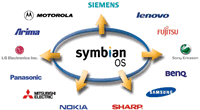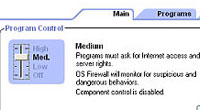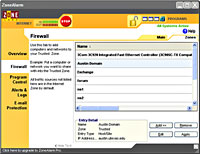 Anyone who enjoyed Mario Kart on the Nintendo SNES back in the 90s will love MicroQuad by Viex Games.
Anyone who enjoyed Mario Kart on the Nintendo SNES back in the 90s will love MicroQuad by Viex Games.
Available on the Palm, Symbian Series 60 and Windows Mobile platforms, this is an old fashioned racing game that packs in an astonishing level of detail and playability.
We tested the game on the Palm Treo 650 and the graphics were fun, fast, slick and ran as smooth as a slippery thing in banana boots sliding over an oil slick.
The game
You certainly get a lot of bang for your buck, with a total of twenty different tracks/levels (that’s four unique tracks, each with five difficulty levels) and – apparently – some hidden unlockable tracks lurking within the game.
Gamers start off by taking part in the Baby Cup, and once enough games are won, they can progress through the Junior Cup, Pro Cup, Master Cup and eventually the Expert Cup.
 At the beginning of each game you can select any one of six different bikes, each offering different strengths and weaknesses (road, off road and grip).
At the beginning of each game you can select any one of six different bikes, each offering different strengths and weaknesses (road, off road and grip).
As well as navigating the ever-curving terrain at high speed, racers have to avoid oil slicks, sticky patches and missiles launched by competing karts.
Playing the game proved to be a whole load of fun, with the bright, colourful tracks, lively animation and attractive scenery making it something of an immersive, compelling experience.
Controlling the game
Playing the game via the Treo’s five-way controller was effortless, with the option to customise the placement and function of handset buttons via the game’s options menu – and there’s even a left-handed mode on offer!
We had no problems running the game off our 2 GB Sandisk SD card and the game proved to be rock-solid in use with no crashes (and we’ve been playing it a lot!).
 The game also offers an internet high score competition, a Bluetooth multiplayer option and a ‘Quick Race’ option if you fancy a quick blast around the tracks.
The game also offers an internet high score competition, a Bluetooth multiplayer option and a ‘Quick Race’ option if you fancy a quick blast around the tracks.
Conclusion
We liked this game. A lot.
It offers great value, exceptionally high quality graphics and a level of gameplay so addictive it can only be described as perilous.
The game’s tough enough to keep you coming back for more too, so you can expect a dramatic slump in productivity as soon as you install the game on your handset!
MicroQuad can be downloaded from Viex.org for just $14.95 (€12, £8).
Scores on the door: Features: 85%
Gameplay: 90%
Graphics: 90%
Value For Money: 95%
Overall: 90%
Compatibility:
Palm OS:
Tungsten E, T, T2, T3 and C
Zire 31 (low resolution), 71 and 72
Treo 600 (low resolution) and Treo 650
Sony Clie Series NX, NZ, TG, TH, TH and UX
Tapwave Zodiac 1 and 2
Pocket PC Windows Mobile 5.0
(tested on a Qtek 2020, a Qtek S100, a HP iPAQ 5550, a HP iPAQ 3950, a HP iPAQ 4700, a HP hx 2750, a Toshiba e800 and a Garmin iQue M5.)
Series60 Symbian
(tested on Nokia NGage, Nokia 6600, Nokia 7610 and Nokia 3650)
 The BPI continued its policy of clamping down on illegal file sharing this week, when it contacted UK ISPs Cable and Wireless and Tiscali with requests to suspend 59 accounts.
The BPI continued its policy of clamping down on illegal file sharing this week, when it contacted UK ISPs Cable and Wireless and Tiscali with requests to suspend 59 accounts. In a statement on 12th July, the BPI stated “Early responses from both companies suggest that they will suspend accounts which have clearly been used for illegal filesharing” and indicated that it could supply detailed evidence on the other 16 Tiscali addresses. In an interview on More Four News Tiscali spokesman Richard Ayres said Tiscali’s message to the record industry is “Come to us, give us the details and we’ll absolutely work with you.” Which would seem to be in contradiction of Tiscali’s own letter, which also stated that “Tiscali does not intend to require its customers to enter into the undertakings proposed by you and, in any event, our initial view is that they are more restrictive than is reasonable or necessary.”
In a statement on 12th July, the BPI stated “Early responses from both companies suggest that they will suspend accounts which have clearly been used for illegal filesharing” and indicated that it could supply detailed evidence on the other 16 Tiscali addresses. In an interview on More Four News Tiscali spokesman Richard Ayres said Tiscali’s message to the record industry is “Come to us, give us the details and we’ll absolutely work with you.” Which would seem to be in contradiction of Tiscali’s own letter, which also stated that “Tiscali does not intend to require its customers to enter into the undertakings proposed by you and, in any event, our initial view is that they are more restrictive than is reasonable or necessary.” Coincidentally, the BPI action comes at the same time that the (US based)
Coincidentally, the BPI action comes at the same time that the (US based)  Steeenkin’ spammers are increasingly turning their evil gaze in the direction of SMS, Web-based instant messaging, bloggers and community sites like MySpace.com, according to MessageLabs.
Steeenkin’ spammers are increasingly turning their evil gaze in the direction of SMS, Web-based instant messaging, bloggers and community sites like MySpace.com, according to MessageLabs. MessageLabs reported that spam mail soared a hefty 6.9% in June to make up a massive 64.8% of all global emails sent that month.
MessageLabs reported that spam mail soared a hefty 6.9% in June to make up a massive 64.8% of all global emails sent that month. Last week the French legislature approved a new law which could radically change the landscape of digital audio. The so-called ‘iTunes Law’ is designed to break the control hardware manufacturers exert over the type of content that can be played by their digital music players and software. The result would be that companies such as Apple, Microsoft and Napster would have to make their data formats interoperable, thereby opening their systems to music from rivals. A regulatory body could be set up to police the sector.
Last week the French legislature approved a new law which could radically change the landscape of digital audio. The so-called ‘iTunes Law’ is designed to break the control hardware manufacturers exert over the type of content that can be played by their digital music players and software. The result would be that companies such as Apple, Microsoft and Napster would have to make their data formats interoperable, thereby opening their systems to music from rivals. A regulatory body could be set up to police the sector. The iTunes Law does, however, leave a get-out for the tech companies. A newly-added clause permits artists to exercise control over additional DRM. In short, artists could object to their music being transferred into other formats, thereby ensuring that current practices could continue unaffected. This loophole would require renegotiation of existing contracts, something Apple et al may wish to avoid given record companies’ desire to recoup perceived losses due to piracy. Lawyers observed that the new law is complex and its impact will be difficult to judge until it is tested in court.
The iTunes Law does, however, leave a get-out for the tech companies. A newly-added clause permits artists to exercise control over additional DRM. In short, artists could object to their music being transferred into other formats, thereby ensuring that current practices could continue unaffected. This loophole would require renegotiation of existing contracts, something Apple et al may wish to avoid given record companies’ desire to recoup perceived losses due to piracy. Lawyers observed that the new law is complex and its impact will be difficult to judge until it is tested in court. UK British music recording industry trade association, the BPi, has today issued a statement that they have “successfully jumped the first hurdle in its battle to have unauthorised Russian download site AllofMP3.com declared illegal.”
UK British music recording industry trade association, the BPi, has today issued a statement that they have “successfully jumped the first hurdle in its battle to have unauthorised Russian download site AllofMP3.com declared illegal.” The argument of the BPI is that AllofMP3 has no right to be selling the music, as they aren’t licensed to do so. AllofMP3 counter that they are “authorized by the license # LS-3М-05-03 of the Russian Multimedia and Internet Society (ROMS) and license # 006/3M-05 of the Rightholders Federation for Collective Copyright Management of Works Used Interactively (FAIR).”
The argument of the BPI is that AllofMP3 has no right to be selling the music, as they aren’t licensed to do so. AllofMP3 counter that they are “authorized by the license # LS-3М-05-03 of the Russian Multimedia and Internet Society (ROMS) and license # 006/3M-05 of the Rightholders Federation for Collective Copyright Management of Works Used Interactively (FAIR).” Some of the most compelling games are often the simplest, and games don’t get much more basic than the age-old game of Battleships.
Some of the most compelling games are often the simplest, and games don’t get much more basic than the age-old game of Battleships. If you miss, you get a splashy sound (and quite possibly the derision of your chum across the room) and if you hit the target you get a gratifying kaboom (with the option to shout and jeer at your opponent’s misery).
If you miss, you get a splashy sound (and quite possibly the derision of your chum across the room) and if you hit the target you get a gratifying kaboom (with the option to shout and jeer at your opponent’s misery). Our opinion
Our opinion Yo! Boom Boom! AOL’s produced a book* new ‘Action Sports On Demand’ website designed for skateboarders, snowboarders and other action sports athletes.
Yo! Boom Boom! AOL’s produced a book* new ‘Action Sports On Demand’ website designed for skateboarders, snowboarders and other action sports athletes. Taking a sniff around the suitably “yoot” style website, we clicked on the ‘About Us’ section, only to be greeted with one of those really annoying, pretentious dictionary-style definitions:
Taking a sniff around the suitably “yoot” style website, we clicked on the ‘About Us’ section, only to be greeted with one of those really annoying, pretentious dictionary-style definitions: Spots! Yeah! Rad!
Spots! Yeah! Rad! Symbian, the smartphone OS company, are pulling a smart move (pun intended) by offering free assistance to Universities and their lecturers to have Symbian programming skills built into courses. Very clever.
Symbian, the smartphone OS company, are pulling a smart move (pun intended) by offering free assistance to Universities and their lecturers to have Symbian programming skills built into courses. Very clever. As a sweetener to the lecturers to get involved, Symbian will provide “exposure to Symbian’s industry partners.” Pretty healthy if you fancy running a software development company and want to get exposure for your potential products, or you’re getting a little bored of Uni life and fancy impressing those in industry that you’re a bit of visionary.
As a sweetener to the lecturers to get involved, Symbian will provide “exposure to Symbian’s industry partners.” Pretty healthy if you fancy running a software development company and want to get exposure for your potential products, or you’re getting a little bored of Uni life and fancy impressing those in industry that you’re a bit of visionary. T-Mobile has finally officially announced the T-Mobile Sidekick 3, adding a new trackball controller, Bluetooth and EDGE data to the popular Sidekick 2.
T-Mobile has finally officially announced the T-Mobile Sidekick 3, adding a new trackball controller, Bluetooth and EDGE data to the popular Sidekick 2. The Sidekick boasts a new 1.3 megapixel camera and assist light, with a large 65k colour, transflective TFT display supporting a rather underwhelming 240×160 pixel resolution.
The Sidekick boasts a new 1.3 megapixel camera and assist light, with a large 65k colour, transflective TFT display supporting a rather underwhelming 240×160 pixel resolution. New for version three is a Bluetooth system supporting both the OBEX Push and Headset/Hands Free profiles and a mini-USB port for transferring files from a PC.
New for version three is a Bluetooth system supporting both the OBEX Push and Headset/Hands Free profiles and a mini-USB port for transferring files from a PC. After happily using Zonelabs’ freebie Zonealarm firewall product for years on end, we were keen to try out their commercial Zonealarm Internet Security Suite 6, which bolts on a ton of extras to tempt skinflints.
After happily using Zonelabs’ freebie Zonealarm firewall product for years on end, we were keen to try out their commercial Zonealarm Internet Security Suite 6, which bolts on a ton of extras to tempt skinflints. Zone Alarm’s anti-phishing widget has also been enhanced, and the privacy protection feature lets users specify what personal information they want protected, e.g. phone numbers, addresses, bank accounts etc.
Zone Alarm’s anti-phishing widget has also been enhanced, and the privacy protection feature lets users specify what personal information they want protected, e.g. phone numbers, addresses, bank accounts etc. Fine tuning and advanced options were also available, but for many users the default settings should be enough to get them up and running within minutes.
Fine tuning and advanced options were also available, but for many users the default settings should be enough to get them up and running within minutes. Although there’s not a great deal new on offer here – save the anti-spyware feature – the Internet Security Suite is a solid product that gives you all the protection you need for a reasonable fifty quid.
Although there’s not a great deal new on offer here – save the anti-spyware feature – the Internet Security Suite is a solid product that gives you all the protection you need for a reasonable fifty quid.